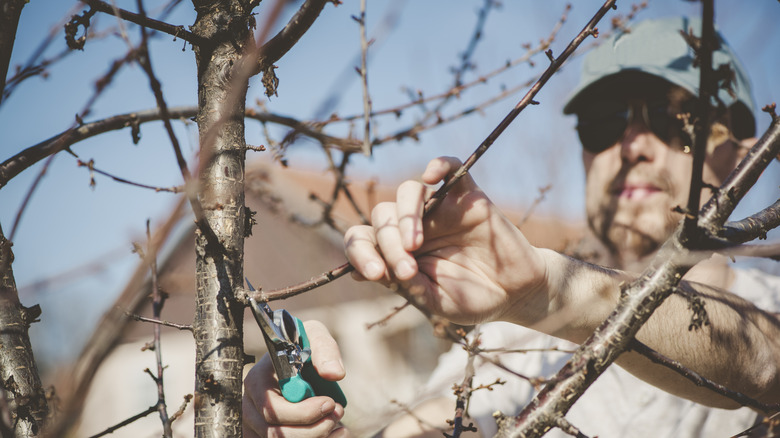The Reason Your Tree's Branches Are Growing Straight Up (And What To Do About It)
Keeping up with your lawn and garden can feel like a full-time job. It always seems that something needs to be done — whether it's mowing the lawn, applying one of the best organic fertilizers to your grass and garden, or getting rid of all of those weeds growing in the driveway cracks. While these tasks may be time-consuming, you at least understand what needs to be done. It's an entirely different story when you discover something that looks off — but that you really can't explain. If you've discovered that the branches on one of your trees are growing straight up, you may be at a complete loss about what is going on and what you should be doing about it.
We were also curious about what could cause something so strange to happen, so we reached out to Allen Tate, a tree health specialist and certified arborist with Blooma Tree Experts. When speaking exclusively with House Digest, he shared that one common cause of this phenomenon is called waterspout growth. Tate explains, "'Waterspout' growth is a reaction of the tree to create more canopy quickly." Ahead, we'll take a closer look at what can cause waterspout growth, other potential causes for tree branches that are growing straight up, and what you should do to fix current issues and prevent them from happening again in the future.
This is why you may be seeing vertical branches growing on your tree
Tree branches that are growing straight up may look strange — or even cartoonish. However, they aren't an indication that a Disney or Pixar creation somehow got transported to your yard. Instead, there is a simple and logical explanation for this growth pattern. "Limbs that are growing straight up are most often 'water sprouts' or growth that takes place after excessive pruning (i.e over thinning, large limbs removed, shearing)," Allen Tate shared when speaking exclusively with House Digest. Some trees are more likely to create these waterspout growths in response to being pruned too heavily. According to Tate, "Trees such as dogwoods, magnolias, and crabapples will produce quick growing, straight growths to recreate lost canopy."
If you're noticing these vertical growths — but haven't recently pruned your trees — there's one other potential explanation. Tate explains, "In very young trees, new growth can also have a straight and vertical orientation as they surge high looking for sun." If your trees are young, then this growth pattern should be more amusing than concerning — they're just trying to get more of those rays from the sun to complete photosynthesis and remain healthy.
How to fix branches that are growing straight up — and how to prevent the problem in the future
Unless your tree is young and simply stretching up to get more sun, branches that are growing straight up are not normal. As Allen Tate explained, it is an indication that you've over-pruned the tree. You obviously can't replace the portions of the canopy that you've removed, so what are you supposed to do about these odd, vertical growths? Your first instinct may be to just cut them all off and let the tree start over and send new branches in the correct direction. However, this is not the best course of action, and is precisely why Tate recommends consulting with a certified arborist. During an exclusive interview with House Digest, he shared, "Best practice is to thin these sprouts and not remove them all at once. The tree will just recreate them! You might thin by removing 30-50% of the sprouts the first year, then another 30-50% the following year. Some of these sprouts should be left to develop into long-term limbs."
You can avoid such major pruning mistakes in the future by being careful to avoid cutting off too much growth at once. "For most trees, pruning no more than 20-30% of live canopy in one growing season is a good limit," explains Tate. He even notes that even sparser pruning is recommended for certain trees, such as dogwoods. If you're uncertain on how much you can safely prune without causing waterspout growths to form, reach out to a certified arborist. They'll be able to work with you to determine the needs of each tree in your yard and what you should do to keep them healthy.


